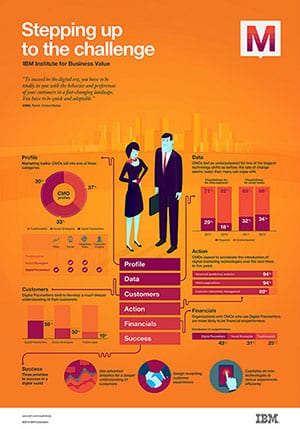 The narrative of public relations, marketing and sales professionals over the last five years has been a shift towards using new forms of media and devices to engage with customers and prospects in two-way relationships.
The narrative of public relations, marketing and sales professionals over the last five years has been a shift towards using new forms of media and devices to engage with customers and prospects in two-way relationships.
This is a move towards becoming a so-called “open business,” or social business, where customers and prospects are no longer viewed as external audiences, rather like staff and other stakeholders, who are embraced as integral parts of the organization.
These types of organizational changes are coming, but progress is slow.
Stepping Up to the Challenge, a new report published by IBM (*client), sheds some light on this evolution. It documents that a mere fifth of organizations have set up social networks to engage with their customers.
Even fewer companies have integrated customer interactions across different channels, or are using analytics to mine customer data to improve decision making.
Today, 82% of chief marketing officers (CMOs) said that they feel under prepared to deal with the data explosion (click to tweet). In 2011, that number was 71%.
This gap could indicate two things — either a worsening situation or greater awareness of the issues facing organizations.
The good news is that digital modernization, and the shift to open business, has gained senior level attention.
IBM reports that marketing is second only to finance in wielding influence on the CEO and in the boardroom, and that senior executives with responsibility for marketing, IT and information are increasingly working together.
The business rationale is compelling. According to IBM, organizations that are tackling these changes by aligning the brainpower and energy of senior executives are more likely to outperform their peers by up to 76%.
IBM has identified three distinct profiles of CMOs relating to the various stages of an organization’s digital transformation:
– Traditionalists (37%) are just setting out. They’re challenged by social media, have yet to integrate offline and online systems, seldom engage with customers via social networks, and have yet to come to terms with the explosion in data and need for analytics.
– Social Strategists (33%) have passed the first few milestones. They have recognized social media’s potential for customer engagement, but have yet to tackle data.
– Digital Pacesetters (30%) are much further down the road. They’re reasonably prepared for the data explosion, and well positioned to handle the increasingly heavy social and mobile traffic.
These differences aren’t academic says IBM. Digital preparedness correlates with financial performance.
The plain fact is that Digital Pacesetters help their organizations grow. Forty-three percent of outperforming organizations, as identified by the IBM study, had a Digital Pacesetter leading marketing at the board level (click to tweet), compared with 25% who had Traditionalists at the marketing helm.
The second-half of the report sets out a pragmatic guide to modernizing an organization around social and digital. Suggestions include using data analytics to get a much deeper understanding of customers and prospects, designing a way to reward customer experiences, and figuring out how to capitalize on new technologies to deliver those experiences smartly and efficiently.
The IBM report is further evidence, if any were needed, that public relations has a role in listening and engaging with every department in a modern organization. Stepping Up to the Challenge, draws on interviews with more than 4,000 senior executives from Asia, Europe, Japan, North America, and South America, as part of its ongoing series of C-suite studies.
*IBM is client of Ketchum in several markets around the world.


